January 27, 2015
By M.D. Johnson
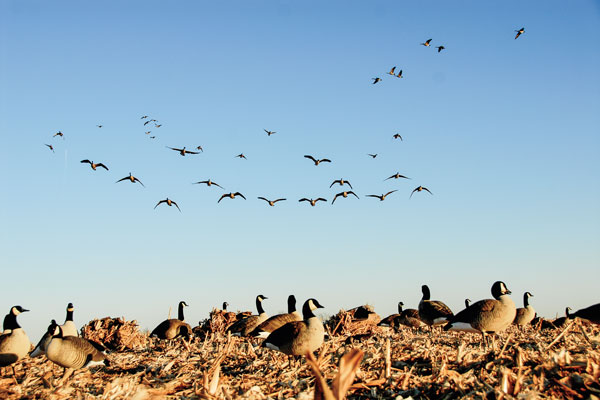 It's become a common sight come November here in the Midwest. Elsewhere too, I reckon, but I'm most familiar with it right here in eastern Iowa, the heart of the Heartland. Big white enclosed trailers, most emblazoned with stickers promoting Outdoor Company A-Z, pulled by F-250 diesel monsters and crewed by four to a dozen camo-clad individuals.
It's become a common sight come November here in the Midwest. Elsewhere too, I reckon, but I'm most familiar with it right here in eastern Iowa, the heart of the Heartland. Big white enclosed trailers, most emblazoned with stickers promoting Outdoor Company A-Z, pulled by F-250 diesel monsters and crewed by four to a dozen camo-clad individuals.
Like a clown car at the circus, these modern-age mammoths churn their way into the center of Cornfield X, where they disgorge said individuals, along with roughly 2.8 million full-body Canada goose decoys. Ninety minutes later, the trucks drive away, but not before there has been created a massive black blob sure to show up on the next satellite pass for Google Earth.
But goose hunters aren't the only ones prone to throwing dozens upon dozens€¦upon dozens€¦of plastics on the ground. Many duck hunters, too, are big on big spreads. Diver enthusiasts have long had the reputation for running rigs of 100 or more blocks because canvasbacks, redheads, and bluebills lounge around all day in huge rafts. Apparently, they enjoy the company of others, so it makes sense for the hopeful 'fowler to cover the water.
Look at any pit on a levee in a southern rice field, and the chances are good you'll see it surrounded by 10-dozen fakes. A permanent blind, be it in the middle of the Mississippi or the edge of a timber hole on Reelfoot Lake? You could walk for 150 yards in any direction, give or take, and never set foot off a decoy.
Advertisement
Now I understand necessity. Big Canada spreads are often a boon, particularly when hunter competition is high or you're dealing with huge flocks of high-flying migrators. Big duck rigs, the same explanation. It's all about drawing power; the more decoys, the more visible the spread, and the more likely it is to grab their attention. Decoys numbering 100 or more — well, it can be a recipe for that kind of success.
But can the opposite hold true? Can a man be consistently successful afield during the latter part of the season with only a handful of decoys? A dozen duck floaters or full-body field mallards? Maybe 24 honkers? Or 14? Or — heaven forbid — six?
Most men with experience in the ways of waterfowl will say yes; however, all will be quick to say that these smaller rigs — these micro-spreads — come with their own considerations, challenges, and payoffs.
Advertisement
It's All Relative
Ask a hundred hunters the same question: define a small spread, please. And I'm sure you'll get at least 95 different answers. The reason is simple. To the Oregonian gunning the Willamette Valley for cacklers and little lessers, a small rig is 15-dozen; all that plastic, they'll tell you, a product of the hyper-social nature of these birds. Lots of company.
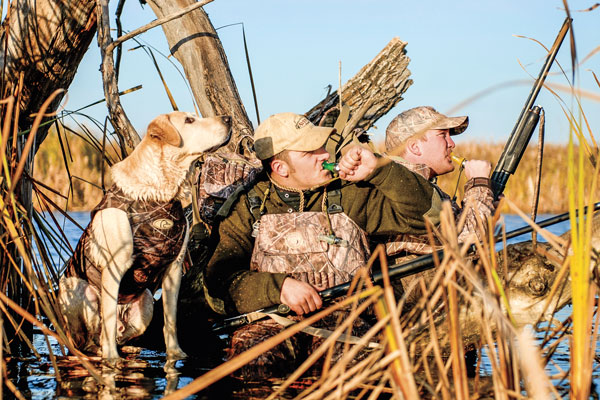 Query the man focusing on late December honkers in eastern Iowa, and he'll tell you small is 18; maybe only a dozen. Small, it seems, all depends on the situation, the species, and, if a man's going to be truthful, the amount of time and effort he wants to spend putting out and picking up faux ducks and/or geese.
Query the man focusing on late December honkers in eastern Iowa, and he'll tell you small is 18; maybe only a dozen. Small, it seems, all depends on the situation, the species, and, if a man's going to be truthful, the amount of time and effort he wants to spend putting out and picking up faux ducks and/or geese.
"Small? That's as few as a pair of duck decoys. Maybe six," says Luke Clark, the public relations guru for Rig 'Em Right. With roots in Oakley, Ill., Clark has darned near two decades of waterfowling history in his back pocket.
"I've had a lot of success hunting small ponds and river channels," he says. But it's all about scouting. And once you start that scouting — really looking — you'll notice birds coming to these places in flocks of five or six or seven. So I'm setting small, trying to duplicate the fresh group — the new birds — as opposed to the entire big mass."
Down in Kentucky, Field Hudnall seems to adhere to the theory of small. "A small spread," says the call-builder and champion, "is relative to what you're accustomed to, the way I see it. If a man's running 1,100 decoys on Reelfoot, then 50 is small. On the Ohio River where we spend a lot of our time, three-dozen is small."
Seven hundred fifty miles west of Hudnall's Ohio River haunts, 29-year-old Zach White, owner and proprietor of Prairie Thunder Outfitters, scores hits on both schools of thought. "My favorite way to hunt ducks is over a tiny creek or river late in the year," says White.
"And a small spread for me here is six to eight decoys. I just want to show new birds that there's birds already there. Big honkers? Two-dozen decoys, but a small spread for little geese like our lesser? Fifteen-dozen is small. It all comes down to differences among the (goose) subspecies."
And then there's the scientific approach to the question. "I've always let the birds determine what my spread looks like," says Mike Galloway. Now 47 and the VP of sales and product development for Hard Core Brands, Galloway spent his formative 'fowling years in northeast Ohio.
"I can put out 100-dozen decoys, if I want," he laughs, "but when I see birds in the late-season breaking into groups of six, eight and 10, then that's what I set. A lot of times I'll carry two bags (12 full-bodies) into the field, and set eight of them."
 But why set a small spread, especially if it's possible to run a larger one? (In Galloways' case, a much larger one). Sometimes, it's a matter of logistics.
But why set a small spread, especially if it's possible to run a larger one? (In Galloways' case, a much larger one). Sometimes, it's a matter of logistics.
"I love big spreads," says Hudnall, "but there's a great pond we hunt that the owner won't let us drive into. That, and it gets terribly muddy. So we run a small spread because that's what we can carry. It's X-number of decoys, often silhouettes if we're hunting geese, per man. Or maybe it's two guys with two six-slot bags of full-bodies each, and the rest with silhouettes," he continued.
Galloway agrees, "The key to being successful, regardless of the number of decoys you set, is to mimic what you're seeing at that particular time of the season," he syas. I don't know a that the 'bigger is better' theory is always good. You take a five-acre wheat field and put out 20-dozen decoys, and it's just not going to look natural."
Downsizing for Ducks
Let's begin with divers. Traditionally, diver spreads and large numbers of decoys — say, 100-plus rigged on old school longlines — were synonymous terms. And the reasons are easy to understand: on big water, there's a need for decoy visibility at a distance, and divers tend to raft in immense groups. That said, can a small spread be effective?
I know a small sandy spit jutting out into the Columbia River in Washington state we've taken to calling The Beach, where, with only 22 bluebill decoys, we can shoot limits when the birds come down in December and January with little problem. Six decoys on each of two longlines; the first angled out to mid-river and downstream, and the second paralleling the shoreline pointed upstream. Between the two and directly in front of the blinds is The Blob, 10 individually rigged blocks set as tight — touching, even — as possible.
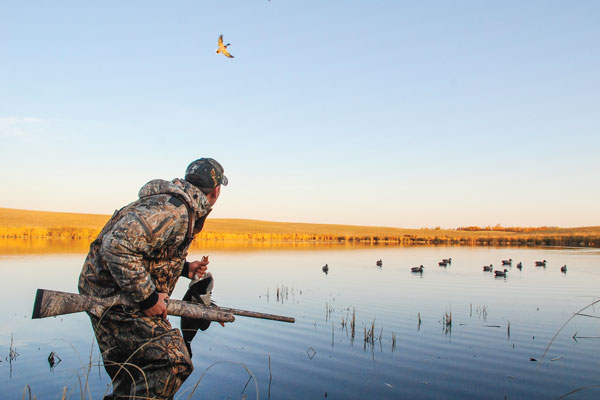 Birds approaching from downstream hit the lower line and follow it into The Blob. This minimalist diver rig works for three reasons: one, small rafts of scaup loaf just off The Beach, without fail, from year to year. Not huge numbers, but with a daily bag limit of around three most years, we never need huge flocks. The birds are already there; we just need a few plastics to set them at ease.
Birds approaching from downstream hit the lower line and follow it into The Blob. This minimalist diver rig works for three reasons: one, small rafts of scaup loaf just off The Beach, without fail, from year to year. Not huge numbers, but with a daily bag limit of around three most years, we never need huge flocks. The birds are already there; we just need a few plastics to set them at ease.
Second, we use all oversized drake decoys, both for the physical size and the high-visibility white. And three, divers are as greedy as snows when it comes to feeding; thus, The Blob simulates an active food source, appealing to their almost constant need to feed.
Puddlers can be quite susceptible to small spreads, especially for the 'fowler who's done his homework. "It's all about being in the right spot," says Hudnall. "If you've found a pond that the birds are already accustomed to, then the only thing that can screw that up is you. You set too many decoys. You don't pay attention to your concealment. The birds want to be there; you're giving them reason not to want to be there."
When using small spreads on bigger water, like the Ohio, Hudnall suggests a departure from what he calls the human way of setting decoys. "Small clusters of decoys," says the calling champ, "are more visible at a distance than are individual decoys. When we hunt the river, we'll set little pods of ducks — three here, five there, six there — instead of one here and then another three feet away and then another three feet away. That type of precise spacing is what I call the human way of setting decoys. Real ducks don't sit that way."
For those hunting the same spot of water throughout the course of the duck season, changing things up is an important, but oft-overlooked element for success. "As the season processes," Galloway says, "I make sure I change my spread. Maybe I'll go from the 36 decoys I've started with to four decoys on a jerk string, and another four set off to one side. Six to 10 floaters is all."
But success with a small spread isn't just about the decoys. "I really don't think there's a disadvantage to running a small duck spread," says White. "But a guy has to have a good game plan when he walks into a situation where he's carrying the whole of his spread on his back, be it ducks or geese. He needs to assess how he's going to set up. How he's going to hide. Strategy becomes important before he goes in to set up."
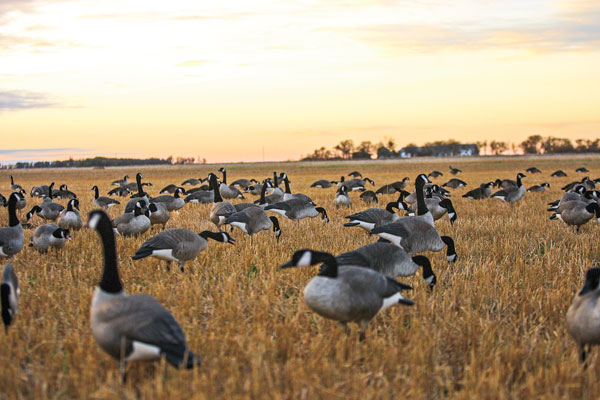 Perhaps most interesting is White's theory on the psychological difference between the 'fowler running a big spread, and the man who tosses 12 decoys onto a pothole. "This man," says the outfitter, "needs to be more patient. And he needs confidence in the process. He's decided to do something different, so his entire outlook on the hunt has to be different. He's not looking for big flocks to finish, but rather two here and two there that work close. And work well."
Perhaps most interesting is White's theory on the psychological difference between the 'fowler running a big spread, and the man who tosses 12 decoys onto a pothole. "This man," says the outfitter, "needs to be more patient. And he needs confidence in the process. He's decided to do something different, so his entire outlook on the hunt has to be different. He's not looking for big flocks to finish, but rather two here and two there that work close. And work well."
A trick I've used over the years when running small duck spreads in shallow water is to combine silhouettes — ducks or geese — with traditional floaters. One, the skinnies provide enhanced visibility at a distance to the on-the-water floaters, especially when I include Canada goose silhouettes. Two, the appear/disappear nature of the two-dimensional silhouettes imparts the illusion of movement within the spread.
Coupled with a jerk cord, it can be a killer combination and quite different from the 24-mallards-and-two-spinners rig the birds are used to seeing from Canada down to southern Louisiana. No, skinnies can't be used in a water spread in every situation, but where they can, they can really make a difference.
Micro-Canadas
Years ago, in a conversation with Ron Latshaw, the man behind the original Eliminator layout blind, I was introduced to the concept of just using eight decoys during the late season. And this mini-rig is designed for educated Pacific Northwest geese, birds that Latschaw said begin earning their diplomas in September, and don't stop learning until well into February. "Three feeders, four sentries, and (maybe) one rester; that's it. One rester, three heads down, and four heads up. A small family group in survival mode that's off by itself. It's interesting," Latschaw explained, "that big flocks of geese — cautious geese — find these small groups intriguing and often, they'll come right to them."
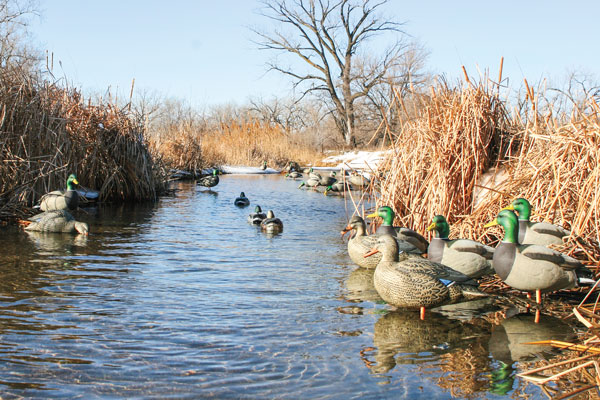 Latschaw elaborated on his eight-fake spread by explaining how everyone — every gun in the group, be it two or 12 — cashes in on Canadas fooled by these meager offerings. "When geese commit to a spread of eight decoys, they're right there," he said. "Everybody's going to get a shot at them because the birds aren't spread (out) across the decoys. With 100 decoys, the birds can land on the left side. They can land on the right side. But it's magic," he continued, "when they commit to eight decoys. They've had it. There's no getting away."
Latschaw elaborated on his eight-fake spread by explaining how everyone — every gun in the group, be it two or 12 — cashes in on Canadas fooled by these meager offerings. "When geese commit to a spread of eight decoys, they're right there," he said. "Everybody's going to get a shot at them because the birds aren't spread (out) across the decoys. With 100 decoys, the birds can land on the left side. They can land on the right side. But it's magic," he continued, "when they commit to eight decoys. They've had it. There's no getting away."
Luke Clark takes Latschaw's mini-rig one step further. "I've had a lot of success later in the year," the young man says, "running just a pair of ultra-realistic Dave Smith (Canada) full-bodies. Why does it work? For one, it's different from all the 'black hole' spreads the birds see. It breaks the mold from today's industry standard. Guys want to unload the trailer, but in areas where there's a lot of (hunting) pressure, you'll notice the birds starting to seclude or isolate themselves in very small groups. When guys set a mass of decoys," he continued, "they'll often sacrifice realism. It becomes a quantity rather than quality thing."
Galloway agrees. "I'd much rather have quality than quantity," he says. "It's got to look natural. Completely natural." He went on to describe one of his favorite late-season micro-spreads for Buckeye State Canadas, one that adheres entirely to his Theory of Realism. "It's a loafing pond situation," he started. "I'll use just four floaters with the first close to the shoreline, and rig them in a line. At the last floater, I'll put a standing full body. Two or three full bodies on the shoreline, along with two or three sleepers. I've created a scene where birds have landed and are swimming to shore, one has just landed, and a half-dozen others are already on the bank. It's all relaxed and content."
Some hunters, Galloway says, want to fill the pond with decoys, subscribing, he assumes, to the principle of bigger is better. "With 100 decoys," he says, "birds expect to hear the noise of 100 birds. See more splashing. One hundred silent geese doesn't look right to a goose. But if you're using eight decoys, well, you're making enough noise (with the call) for eight geese. Or enough movement in the water for eight geese. It's all about being natural."
Like Hudnall, I'm partial to my 18 full bodies when gunning dry ground during December and January. "I'll set one pod of eight feeders," says the Kentuckian. "Then one of five, three, and then a pair. I'll concentrate the feeders tight, like they've found a good feed, and use the smaller pods to create a rough hole where I want the birds to light."
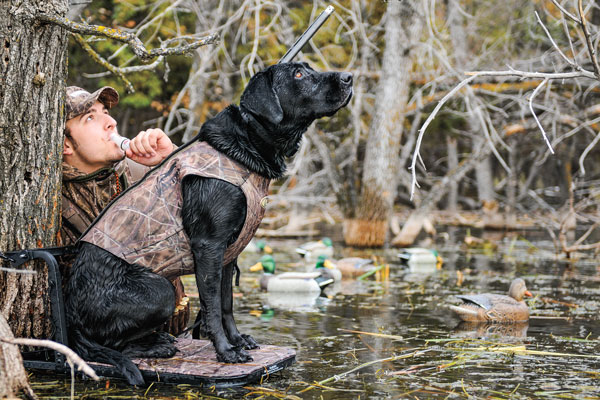 My go-to rig is similar, 10 feeders in a loose ball, with three pairs of feeders/actives widely spaced and "walking" into the ball. Finally, an active or sentry pair, set as if they'd just landed and are working to catch up to the feeding actives. For whatever reason, geese seem to key in on the just-landed pair, so I'll set those as my hole, quartering the wind with the blind so the birds, on-approach, are staring at the decoys, not at me.
My go-to rig is similar, 10 feeders in a loose ball, with three pairs of feeders/actives widely spaced and "walking" into the ball. Finally, an active or sentry pair, set as if they'd just landed and are working to catch up to the feeding actives. For whatever reason, geese seem to key in on the just-landed pair, so I'll set those as my hole, quartering the wind with the blind so the birds, on-approach, are staring at the decoys, not at me.
But if you hunt this way, there's one thing you must do above all. "If you're going to use a small spread," says White, "you have to hide really well." Says Hudnall, "It's like trying to hide layout blinds in a bean field. There's just nothing to take the birds' attention off the blinds, so you have to hide well."
"If I take 30 minutes putting out decoys," says Galloway, "I spend an hour camouflaging the blind. And when I talk about using small spreads, I'm not talking about me and four other guys. It's too much to cover up. It's me and my son. Or me and dad. With small spreads, I'm specifically targeting small groups of birds."
Young Lucas Clark put it best. "You can run the prettiest goose decoys on the planet, be that 100 or two, but if you're not hidden, they might as well be painted blaze orange. If you want to be successful, hide first. Decoy placement is important. Scouting reveals all the answers. But if you're not hidden, you're not shooting."
Simple as that.
